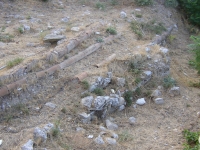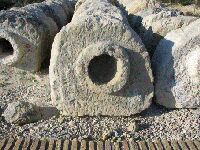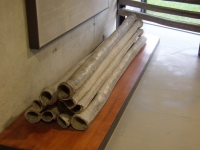


Pipes
According to Vitruvius, water could be conducted in three ways (8.6.1):Water can be conducted in three ways: by flow in masonry channels, lead pipes and terracotta pipes.Pipes were not only made of terracotta, lead, stone, and clay, but also of wood or leather. The use of all four has been found in Roman aqueducts (Hodge, 2002:106). Terracotta was the most common, followed by lead and then stone. Wood was rare in southern Europe, but more common than stone and lead in northern Europe and Britain. Pipes are more difficult to maintain than open channels, so it is likely that, and the evidence suggests, that pipes were used less than channels. Nonetheless, both Vitruvius (8.6.1) and Pliny (Nat.His 31.57) provide detailed specifications for the use of pipes. Terracotta pipes called tubuli were the second most common material used for the construction of aqueducts, but were only suitable for low-pressure applications. They are found in some of the smaller main-line aqueducts, local urban distribution systems and even in drains. The individual sections are usually around 40-70 cm long with an internal diameter of up to fifteen cm. The length might have been dictated by the fact that they were made on a potter's wheel. They were not symmetrical, the one end was narrower than the other end so they could be joined, the narrower of one section fitting neatly into the wider end of another section, with a flange or groove to help seal the joint. A plaster, similar to the plaster used in the masonry channels, was used to complete the seal.
One unique method, used only in Bibracte in Burgundy, boasts a pipeline made entirely of re-used wine amphorae, their tops and bottoms knocked off so they fitted snugly into each other. The short length of terracotta pipes meant there were a large number of joints in a pipeline.
A number of the pipes had openings in their tops, with removable lids, presumably to allow for cleaning. These lids would probably have leaked. One of the extant lids, now on the left wall of the vestibule of the S. Maria in Cosmedin in the Forum Boarium, is the so-called Bocca della verita, or "Mouth of Truth". According to legend, if a liar was to put his or her hand in the mouth, it would be bitten off (Hintzen-Bohlen, 2000:364).
A metal pipe, or fistula, was also used. Sometimes bronze was used, but more often the less expensive lead was used. The Roman method of making lead pipes can be seen in the remains at Bath in Somerset, England. A rectangular sheet of lead was folded, probably around a wooden former, into either a circle or a triangle with rounded corners. The two edges either had a simple overlap and were soldered closed, or were overlapped and folded then soldered. There were ten standard size, each named from the width of the sheet of lead used. The sized were measured in digits, one digit being 1.85 cm. Lead pipes were made in sections longer than earthenware pipes, but with thinner walls (Landels, 2000:44).
Vitruvius prefers the use of earthen ware for several reasons. Firstly, he believed that there is a danger of lead poisoning from the formation of white lead oxide in lead pipes. Vitruvius calls this substance cerussa. As evidence of the ill effects of lead he points out the unhealthy symptoms shown by workers in lead smelting and casting; however, he does not know that working with lead is far more dangerous than drinking water that has passed through lead pipes. Secondly, it requires workmen with specialist skills to carry out construction, while an ordinary bricklayer can deal with earthenware pipes. Vitruvius is probably mistaken in this, as the bricklayer would have required training and experience in order to work with pipes. Thirdly, Vitruvius states that lead is more expensive than earthenware pipes. This is no doubt true. The cost of transporting lead must have been prohibitive.
There are two problems associated with closed-pipe systems. These are pressure and sediment. If the pipe falls a long way below either the source of the delivery point, the water develops a pressure which works out at approximately 1kg/cm2 for every 10 metre head. If this pressure rises above the order of 3.5kg/cm2 it begins to have several potentially serious effects. Lead pipes tend to split open at their joins, and earthenware pipes crack along any flaws or weaknesses. The joints in sections in both tend to blow apart. This is not a serious problem when they are all in a straight line, or curved gradually up or down, since the weight of the joints is held together by the weight of the system as a whole. However, as Vitruvius points out, if there is a sharp bend between a vertical and a near-vertical section and a horizontal one, there is a great danger of bursting because the thrust of the water has to be taken by the joint itself. To remedy this problem when using earthenware pipes, Vitruvius suggests enclosing the entire elbow (or knee, as he calls it) in red sandstone.
The problem of sediment was defeated in several ways. The most effective was the settling tank. The water was fed in at one end, and if the rate of traverse was slow enough, most of the sediment would sink to the bottom before the water exited at the opposite end.
From the thesis of Evan J. Dembskey on The aqueducts of Ancient Rome